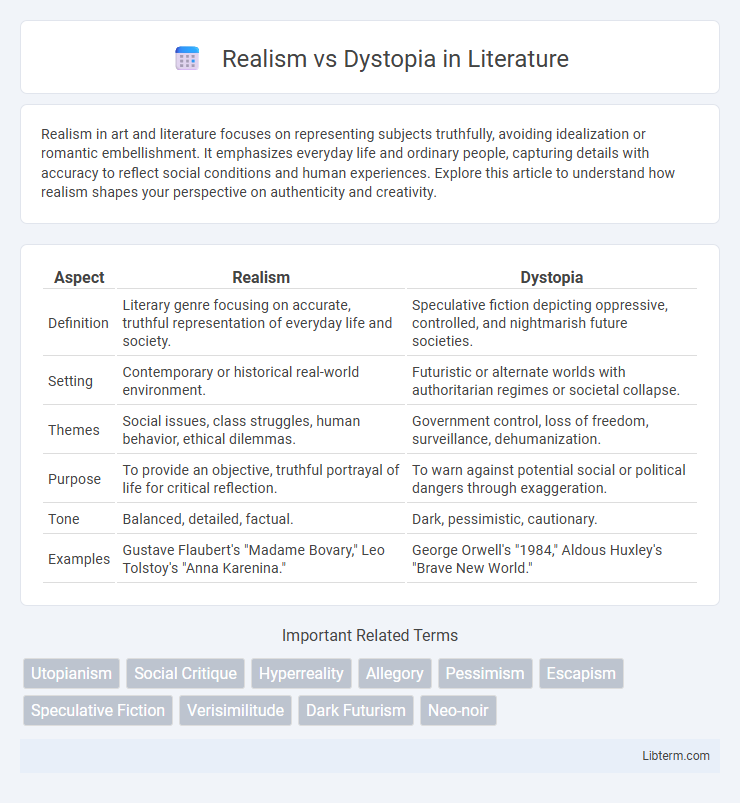Realism in art and literature focuses on representing subjects truthfully, avoiding idealization or romantic embellishment. It emphasizes everyday life and ordinary people, capturing details with accuracy to reflect social conditions and human experiences. Explore this article to understand how realism shapes your perspective on authenticity and creativity.
Table of Comparison
| Aspect | Realism | Dystopia |
|---|---|---|
| Definition | Literary genre focusing on accurate, truthful representation of everyday life and society. | Speculative fiction depicting oppressive, controlled, and nightmarish future societies. |
| Setting | Contemporary or historical real-world environment. | Futuristic or alternate worlds with authoritarian regimes or societal collapse. |
| Themes | Social issues, class struggles, human behavior, ethical dilemmas. | Government control, loss of freedom, surveillance, dehumanization. |
| Purpose | To provide an objective, truthful portrayal of life for critical reflection. | To warn against potential social or political dangers through exaggeration. |
| Tone | Balanced, detailed, factual. | Dark, pessimistic, cautionary. |
| Examples | Gustave Flaubert's "Madame Bovary," Leo Tolstoy's "Anna Karenina." | George Orwell's "1984," Aldous Huxley's "Brave New World." |
Understanding Realism: Core Principles and Features
Realism emphasizes accurate, detailed depiction of everyday life, focusing on plausible scenarios and complex characters driven by motivation and environment. It prioritizes objective observation and social critique, portraying the ordinary without exaggeration or fantastical elements. Key features include verisimilitude, ethical complexity, and an emphasis on middle-class settings reflecting societal norms and struggles.
Defining Dystopia: Characteristics and Origins
Dystopia is a genre characterized by oppressive social control, often under totalitarian regimes or environmental disasters, highlighting a nightmarish vision of the future. Its origins trace back to early 20th-century literature, with seminal works like George Orwell's "1984" and Aldous Huxley's "Brave New World" establishing core themes of surveillance, loss of individuality, and societal decay. The genre contrasts sharply with Realism by emphasizing speculative, exaggerated worlds designed to critique contemporary social and political issues.
Historical Evolution: Realism and Dystopia in Literature
Realism in literature emerged in the 19th century as a response to romanticism, emphasizing everyday life and truthful representation of society's conditions, as seen in the works of authors like Gustave Flaubert and Leo Tolstoy. Dystopian literature, evolving prominently in the 20th century with George Orwell's "1984" and Aldous Huxley's "Brave New World," critiques totalitarian regimes and societal decay through imagined oppressive futures. The historical evolution of both genres reflects shifting cultural concerns, with realism focusing on contemporary social realities and dystopia projecting fears about future political and technological developments.
Core Differences: Realism vs. Dystopia Explored
Realism depicts life and society as they are, emphasizing accurate, detailed portrayals based on everyday experiences and plausible events, whereas dystopia envisions oppressive, nightmarish worlds marked by totalitarian regimes, environmental disasters, or technological domination. Realism aims to reflect truth and complexity without exaggeration, while dystopia exaggerates negative possibilities to critique current societal trends or warn against potential futures. The core difference lies in realism's focus on authentic representation versus dystopia's speculative portrayal of systemic collapse and human suffering.
Societal Reflection: How Realism Mirrors Reality
Realism in literature and art serves as a direct mirror to societal norms, behaviors, and struggles, providing an authentic portrayal of everyday life that highlights social issues without embellishment. This approach emphasizes accurate, detailed depictions of characters and settings, allowing audiences to recognize and reflect on their own experiences and societal conditions. Unlike dystopian narratives that project exaggerated or speculative futures, realism grounds its critique in present realities, fostering a deeper understanding of current social dynamics and challenges.
Cautionary Tales: The Purpose of Dystopian Worlds
Dystopian worlds serve as cautionary tales by exaggerating real societal issues to highlight potential consequences of current political, social, or technological trends, emphasizing the urgency for change. Realism grounds narratives in plausible developments, contrasting with dystopia's speculative scenarios that warn against unchecked power, environmental collapse, or loss of individual freedoms. These cautionary tales encourage critical reflection on ethical governance, human rights, and the balance between progress and control.
Key Themes: Conflict, Control, and Human Nature
Realism explores conflict through authentic depictions of everyday struggles, emphasizing human nature as complex and multifaceted, while dystopia exaggerates conflict to reveal societal flaws and the consequences of totalitarian control. Control in realism often manifests through social, political, or economic forces shaping characters' choices, whereas dystopia highlights oppressive regimes or technology enforcing absolute dominance. Both genres examine human nature's resilience and vulnerability, but dystopia typically underscores the dehumanizing effects of power and systemic manipulation.
Impact on Readers: Engagement and Emotional Response
Realism immerses readers in authentic, relatable scenarios that foster deep emotional connections and personal reflection, enhancing engagement through believable characters and settings. Dystopia captivates by presenting exaggerated societal flaws and high-stakes conflicts, provoking strong emotional reactions such as fear, hope, or outrage. Both genres impact readers by stimulating critical thinking and empathy, but realism grounds emotions in everyday truths while dystopia amplifies them through speculative extremes.
Modern Examples: Realism and Dystopia in Contemporary Works
Modern literature and film often blur the lines between realism and dystopia, exemplified by works like Margaret Atwood's *The Handmaid's Tale* and Cormac McCarthy's *The Road*. These narratives use realistic settings and plausible societal collapse to explore themes of oppression, survival, and human resilience, illustrating the stark consequences of current socio-political trends. Contemporary dystopian works emphasize the immediacy of environmental crises and authoritarian governance, reflecting and critiquing modern anxieties through immersive, believable worlds.
The Future of Storytelling: Blending Realism and Dystopia
The future of storytelling increasingly blends realism and dystopia to create immersive narratives that resonate with contemporary audiences. By integrating authentic societal issues with speculative dystopian settings, creators evoke emotional engagement while provoking critical reflection on potential futures. This fusion enhances the impact of stories, making them both believable and cautionary, driving meaningful discourse on technology, environment, and human behavior.
Realism Infographic

 libterm.com
libterm.com